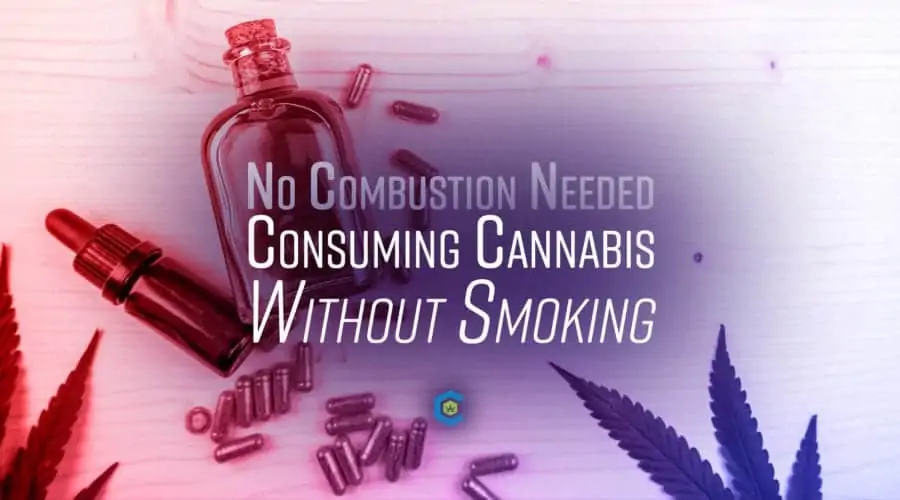Going Smokeless: Consuming Cannabis Without Combustion
Medical Cannabis in the Modern Day: A Diversity of Choices Beyond Flower
 Visiting a cannabis dispensary can be an overwhelming experience, but in a good way. Patients are often amazed at just how many options there are to choose from. Long gone are the days of your local dealer having one purported “sativa” and one “indica” strain of flower with the occasional pot brownie for sale. Today, patients can choose from a multitude of options, including a wide variety of confections and edibles, vape pens, concentrates, even transdermal patches! While each formulation has it’s own advantages and disadvantages, many patients find combination therapy to be the most effective and use different products to help meet their treatment goals and needs. This article will examine some of the many options available to medical cannabis patients today.
Visiting a cannabis dispensary can be an overwhelming experience, but in a good way. Patients are often amazed at just how many options there are to choose from. Long gone are the days of your local dealer having one purported “sativa” and one “indica” strain of flower with the occasional pot brownie for sale. Today, patients can choose from a multitude of options, including a wide variety of confections and edibles, vape pens, concentrates, even transdermal patches! While each formulation has it’s own advantages and disadvantages, many patients find combination therapy to be the most effective and use different products to help meet their treatment goals and needs. This article will examine some of the many options available to medical cannabis patients today.
Vaporization: Dry Flower, Lower Heat and Flavorful Vapor
The first method of smokeless cannabis consumption to discuss is simply using a dry herb vaporizer to create a smokeless vapor from the buds that contain the cannabinoids and terpenoids from the flower, which can then be consumed just as one would smoke, but without the tar and toxins that come with smoking just about anything. A recent 2016 study discusses the benefits of “therapeutic cannavaping” by stating it “could be an efficient route for cannabinoids administration because less concentrated cannabinoids-enriched liquid refills are required.” 1
However, it is important to note that the entire cannabinoid profile generally cannot be released into the vapor at once. Different cannabinoids are released into the vapor at different temperatures. CBN, a cannabinoid responsible for the sedative effects of cannabis, requires high temperatures (160-180 degrees Celsius). However, many other cannabinoids, including THC, would degrade at those temperatures.2 Therefore, while this method of consumption greatly reduces the stress on one’s lungs compared to smoking, the full cannabinoid profile cannot be obtained by this mechanism of delivery.
Hashology: Hashish Sets Precedent For Cannabis Concentrate Evolution
The earliest form of cannabis concentrates is known as hashish, or hash. In cultivating and harvesting cannabis plants, large amounts of trichromes (crstyalline structures containing cannabinoids and terpenoids), also known as “keef”, would get stuck to the workers fingers. After sufficient accumulation, the keef could be rolled up into bricks or balls to consume by smoking at the time. While smoking hash is outside the scope of this article, it is important to note that early hash set the precedent for the wide range of cannabis concentrates that can be consumed via vaporization today.
Vaporization: “Dabbing” Cannabis Concentrates
While hashish, also known as “charas” in India, were the concentrates of the olden days, modern-day cannabis extracts and concentrates have made incredible progress. Concentrates generally have a wide variety of names that generally speak to its consistency and are often determined after the extraction process is complete. Common terms are “budder”, “shatter”, “wax”, “live resin”, “live wax”, and “sugar” to name a few. The term “live” refers to flash freezing flower and retaining the maximum amount of cannabis-derived terpenes for a delicious, flavorful taste and wholesome, nuanced effect.
From One-Dimensional to Full-Spectrum: The Evolution of Concentrates
It’s interesting to note that early concentrates simply extracted high amounts of THC and perhaps small amounts of other cannabinoids, thus creating a very “one-dimensional high”; a psychoactive effect lacking the subtleties and nuance of flower. Today, with the technology available to us, this couldn’t be further from the truth. By retaining a wide spectrum of the original cannabis-derived terpenes and cannabinoids, a more wholesome and complete flavor and effect can be achieved with concentrates.
Like A Grown-Up Kid in a Candy Store: The Delectable Edibles of Cannabis
 We’ve come a long way from the old school pot brownies Eric’s parents accidentally ate on an episode of “That 70’s show”. Today, cannabis can be taken orally in a multitude of ways from capsules, to gummies, chocolates, candies, sports drinks, potato chips and more! Furthermore, patients who utilize RSO (Rick Simpson Oil) or simply “cannabis oil” also consume this orally or use it to create edibles of their own. Aside from the delicious nature of this method of consumption, oral cannabinoids have several health benefits.
We’ve come a long way from the old school pot brownies Eric’s parents accidentally ate on an episode of “That 70’s show”. Today, cannabis can be taken orally in a multitude of ways from capsules, to gummies, chocolates, candies, sports drinks, potato chips and more! Furthermore, patients who utilize RSO (Rick Simpson Oil) or simply “cannabis oil” also consume this orally or use it to create edibles of their own. Aside from the delicious nature of this method of consumption, oral cannabinoids have several health benefits.
Oral Cannabinoids and Their Recognized Health Benefits
When combined with lipids (fats), since cannabinoids are fat-soluble compounds, it has been found that co-administration of oral cannabinoids with lipids leads to higher levels of these compounds in the lymph, a part of the body that controls the immune system.3 Furthermore, oral cannabinoids have already established themselves as efficacious treatments in chemotherapy-induced nausea and vomiting.4
Topical & Transdermal Cannabinoids
 Topical and transdermal cannabis products come in several varieties including oils and balms that can be applied topically to the skin and transdermal patches that disperse medication through the skin and into the bloodstream directly. This is particularly helpful since oral administration of cannabinoids such as cannabidiol (CBD) is poor and can be more effective when directly applied to the area needing treatment. While the health benefits of such mechanisms of cannabinoid delivery are still sometimes contested, they have shown promise in the treatment of rheumatoid arthritis and it’s associated inflammation and pain.5
Topical and transdermal cannabis products come in several varieties including oils and balms that can be applied topically to the skin and transdermal patches that disperse medication through the skin and into the bloodstream directly. This is particularly helpful since oral administration of cannabinoids such as cannabidiol (CBD) is poor and can be more effective when directly applied to the area needing treatment. While the health benefits of such mechanisms of cannabinoid delivery are still sometimes contested, they have shown promise in the treatment of rheumatoid arthritis and it’s associated inflammation and pain.5
To learn more about topical & transdermal cannabinoids for Rheumatoid Arthritis, click here!
So Many Choices, Which One Is Best For Me?
While the ways to consume cannabis seem to be ever increasing, it is important for patients to ask themselves what they are trying to achieve to determine what products work best for them. Smoking or vaporizing cannabis has the benefit of rapid onset of effects; effective for nausea and pain relief. Smoked cannabis has also shown promise in Crohn’s patients.6 Patients looking for longer lasting effects would benefit from oral consumption while the arthritic patient may benefit from consistent use of topical cannabinoids. By strategically setting one’s treatment goals and exploring what is available, it’s clear that there’s a little something for just about everyone!
Works Cited
- Varlet, V. et al. Drug vaping applied to cannabis: Is “Cannavaping” a therapeutic alternative to marijuana? Sci. Rep. 6, (2016).
- Wang, M. et al. Decarboxylation Study of Acidic Cannabinoids: A Novel Approach Using Ultra-High-Performance Supercritical Fluid Chromatography/Photodiode Array-Mass Spectrometry. Cannabis Cannabinoid Res. 1, 262–271 (2016).
- Zgair, A. et al. Oral administration of cannabis with lipids leads to high levels of cannabinoids in the intestinal lymphatic system and prominent immunomodulation. Sci. Rep. 7, 14542 (2017).
- Badowski, M. E. A review of oral cannabinoids and medical marijuana for the treatment of chemotherapy-induced nausea and vomiting: a focus on pharmacokinetic variability and pharmacodynamics. Cancer Chemother. Pharmacol. 80, 441–449 (2017).
- Hammell, D. et al. Transdermal cannabidiol reduces inflammation and pain-related behaviours in a rat model of arthritis. Eur. J. Pain Lond. Engl. 20, 936–948 (2016).
- Naftali, T. et al. Cannabis induces a clinical response in patients with Crohn’s disease: a prospective placebo-controlled study. Clin. Gastroenterol. Hepatol. Off. Clin. Pract. J. Am. Gastroenterol. Assoc. 11, 1276-1280.e1 (2013).



Pingback: Cannabis medicinal: Un Aliado en la Salud y el Bienestar - Astro Growshop